How to Grow the Fastest, Easiest Container Garden
What if you could grow food in 2-3 weeks in a small space at any time of year? Microgreens are the way! In this post, I’ll show you how to start growing your own microgreens. I like to think of this as the fastest, easiest version of container gardening!
Microgreens can be used in a salad, smoothie, stir fry, or any other dish where sprouts or baby greens work well. The greens have a nice crunch for a fresh, simple snack on their own. I prefer them to sprouts because they don’t need daily rinsing and can be harvested over a longer period of time.
And this is a great project to do with kids because it’s FAST! While you’ll wait 2-3 months for most veggies, they can clip and start eating from your mini-garden in just 2-3 weeks.
Click here to download the printable tutorial: How to Grow Quick & Easy Microgreens
This tutorial started as a live video on Facebook. I’ll embed it at the end of this post.
How to Grow Quick and Easy Microgreens
Microgreens are young edible seedlings. Older than sprouts and younger than “baby greens,” microgreens pack a lot of nutrition and flavor in a versatile little plant package.
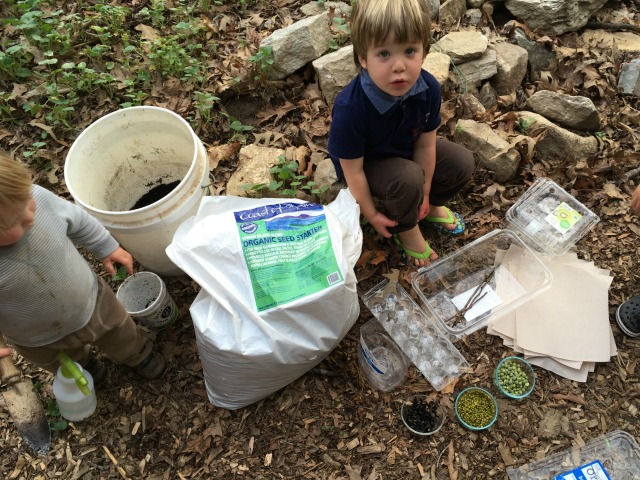
Materials
- Shallow container (A 1-2″ tall container works well because you can cut them fairly flush with the soil when you harvest.)
- Lid or dish for catching excess water
- Organic seed starting soil mix
- Look for a sterile, fine-textured soil-less product with compost, coconut coir/peat moss, and perlite/vermiculite.
- Here are two options we’ve used: Eco-co Coir Potting Mix and Coast of Maine Seed Starter
- Organic seeds
- 1/4 tsp per square inch for larger seeds and
- 1/8 tsp per square inch for smaller seeds. (An 11” x 6” recycled greens clamshell = 1/3 cup large seeds or 1/4 cup small seeds.)
- Pro Tip ✨ Look for sprouting seeds or seeds in bulk from a trusted organic grocer or online seed supplier.
- Pea, sunflower, mung bean, radish, mustard, and broccoli are usually easy to find and grow.
- If you’re feeling adventurous, you can try amaranth, beet greens, or chervil.
- For more ideas, check out the sprouting and microgreen collections from Sow True Seed, Johnny’s Selected Seeds and High Mowing Organic Seeds.
- Paper towels
- Clean water
Tools
- Drill, ice pick, nail, or sharp knife for making drainage holes
- Water spray bottle
- Sunny window or grow light
- Scissors
Advance Preparation
I recommend doing these steps in advance, especially you’re planting with kids.
- Gather materials and tools.
- Drill or poke drainage holes in the bottom of your growing container(s), if needed.
- Moisten soil mix until it sticks together (without being drippy).
- Soak larger seeds, like peas and sunflowers, for 8-12 hours. Drain using a colander just before you’re ready to plant.
- Pull off a few pieces of paper towel for each container.
- Setup shelf near sunny window or under a grow light.
Plant Your Greens
1. Add 1 inch of soil mix to your container and press it flat with your hand. (You’re firming it up, but not compacting it.)
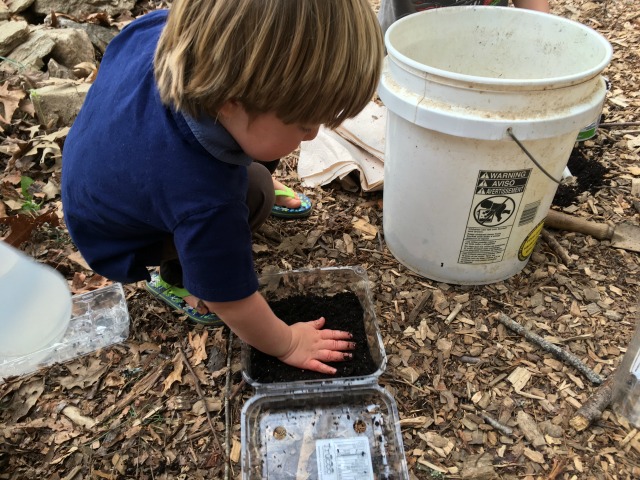
2. Spread seeds densely and evenly over the soil surface. (If you use the measurements above, you’ll end up with about 6-8 large seeds per square inch or 10-12 small seeds per square inch.)
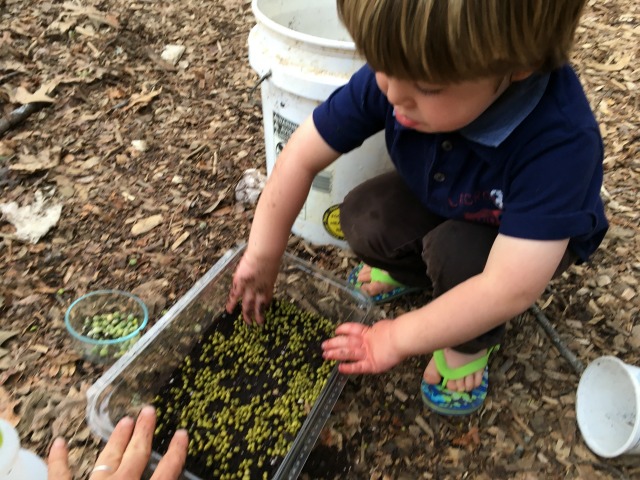
These mung beans are probably planted a little too densely. We’ll see how they do!
3. Press the seeds gently, so they have contact with the soil.
4. Mist with water.
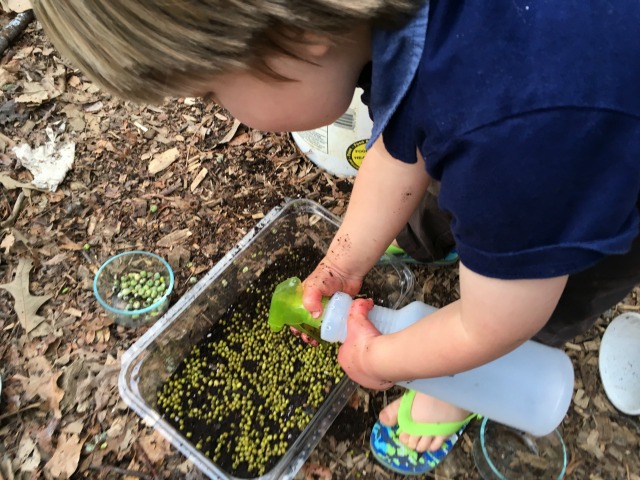
5. Cover with 2-3 layers of moist paper towel.
6. Set the container on a lid or dish to catch excess water. Then, place in a warm, protected place. Most seeds will be fine in the dark at first, and a few seeds need darkness to sprout. Water with spray bottle as needed.
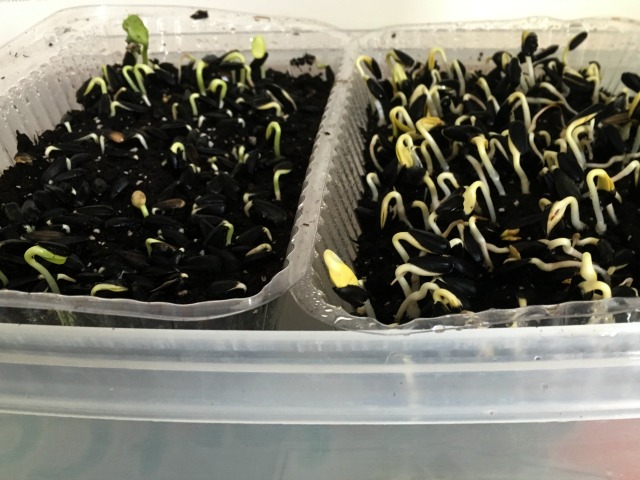
In my tests, the sprouts in the dark at first (on right above) had higher germination rates. Perhaps because they stayed more evenly moist. I’d just moved them into the sun in this picture, and they’ll start to green up now. I’d suggest trying a similar test to see what your results are like!
7. When the seeds sprout, remove the paper towel and move the container to a sunny window or under a grow light.
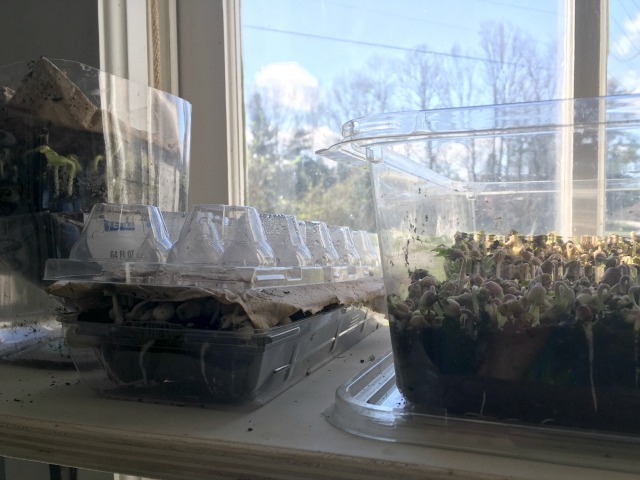
8. Water regularly, keeping the soil moist but not dripping. (You shouldn’t see much water in the bottom “catch” container.) Depending on temperatures and humidity levels, you may need to water as much as twice a day.
Harvesting Your Greens
- Use scissors to cut greens off close to soil level. Give them a quick rinse and toss, blend, cook, or eat right away.Although you can begin harvest as soon as the seedlings green up, microgreens are usually harvested when the “true leaves” appear about 2-3 weeks after planting.The first leaves you see are the cotyledons, or seed leaves. Sometimes heart-shaped, the cotyledons look
different from the typical or “true leaves” that you may be familiar with from mature plants.Get to Know Your Cotyledons
Learn the looks of the earliest sprouts. In the garden, this familiarity helps you know which seedlings to keep and which ones to weed out while plants are young and easy to pull!
- Rinse and eat! Store extra harvested greens in a bag or covered container in the fridge.
- Allow the rest of the container to grow until you’re ready to eat. Due to density, these seedlings aren’t good candidates for outside planting unless you’ve thinned them strategically.
- After a container is harvested, you can…
- Reuse the soil, but only if you don’t have any disease or mold problems. Use a coarse sieve to sift out any remaining roots and stems. (Toss those in the compost.) Mix in a handful of vermicompost and/or organic fertilizer (follow package directions). Repack the soil and plant again.
- Dispose of the soil mix in your compost or worm bin. If you have any doubts about mold or other soil problems, go this route. Then, use fresh soil mix for your next batch of microgreens.
Troubleshooting
Poor germination
Low germination rates are most likely due to either poor seed quality or dry soil. Poor seed quality can mean seeds have been stored improperly in hot, humid conditions or if seeds are old. (“Old” is relative for different types of seed. Look up seed viability for details.)
If your soil dries out before germination or early in the plant’s life, your seed/plant may not may not have enough water to start growing. For large seeds, you can pre-soak to increase germination rates.
Mold or stinky smell
Your seeds are starting to rot. 😭 Since you’re eating them, it’s safest to compost these and start fresh. Wash your containers well before using them again. (You can sterilize them in a diluted bleach or hydrogen peroxide dip.) You may need to water less, plant the seeds less densely, or add a fan for better ventilation.
Leggy or pale
Your greens likely need more light. ☀️ You can try moving the seeds outside (in indirect light) for 4-6 hours on warm days. They may need extra water, especially if it is hot or windy!
If you’d like to grow micro-greens and other seedlings on a regular basis, you might want to invest in a special “grow light” for your setup.
Watch the Video Tutorial
Have you grown sprouts or greens inside before?
Share your experience in the comments below!

Hi Amy, although I’m new to growing microgreens, I’ve been doing alfalfa sprouts in the refrigerator since I was a teen. This will work for all smaller seeds, such as chia, alfalfa, amaranth or radish. All i do is rinse and drain the seeds then spread across the bottom of a flat glass pan. I usually use a damp paper towel to keep them moist and then put the whole pan in a clear plastic bag. Leave out on the countertop overnight, when you seed germination usually in about one day you can put rinse, drain, then put in the refrigerator.
I’m excited to try growing my own microgreens, so thanks for your video and tips.
I would add that sometimes a serrated knife, used in a sawing motion on the bottom edge of a plastic bubble pack will cut through it gracefully (rather than the pointed tip). Also experiment using different kinds of sharp objects… I have found that one of my grilling forks has very slender, sharp points that work fabulously to poke holes in the bottom of yogurt cups.
Thanks, Korrina! I’d love to hear more about your alfalfa sprouts method. Sounds like you have a nice system. Do I understand correctly that you’re actually growing them in the fridge after they germinate? How long do you grow them and are you rinsing them daily? I’m so curious!
Good tips on gracefully cutting through the bottom of the plastic dishes. I realized as I jabbed that this would be a parents-only step. Yours are much less stabby and more older-kid-friendly for sure! I’ll have to look through my drawers for other potential tools to use. 🙂